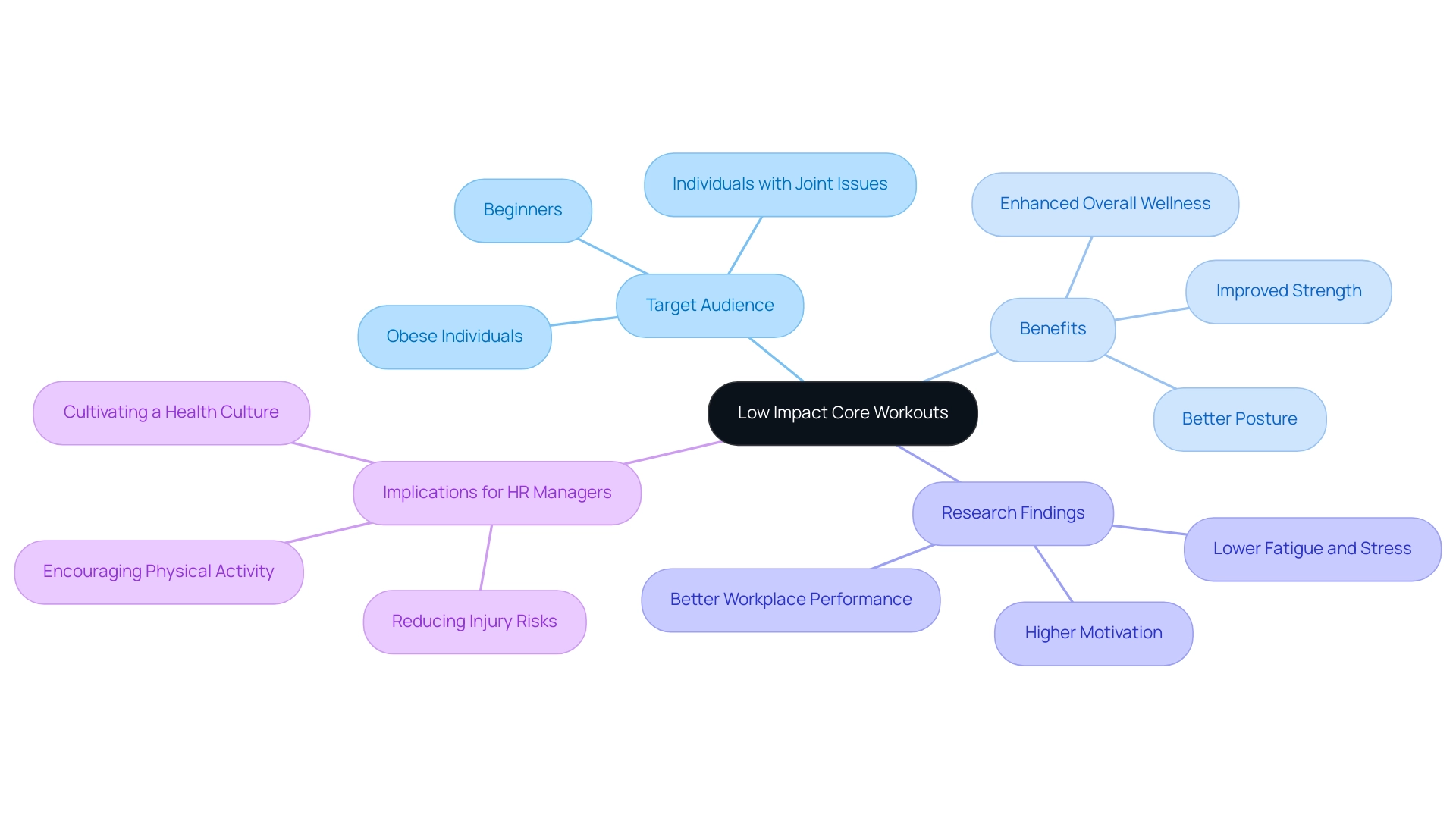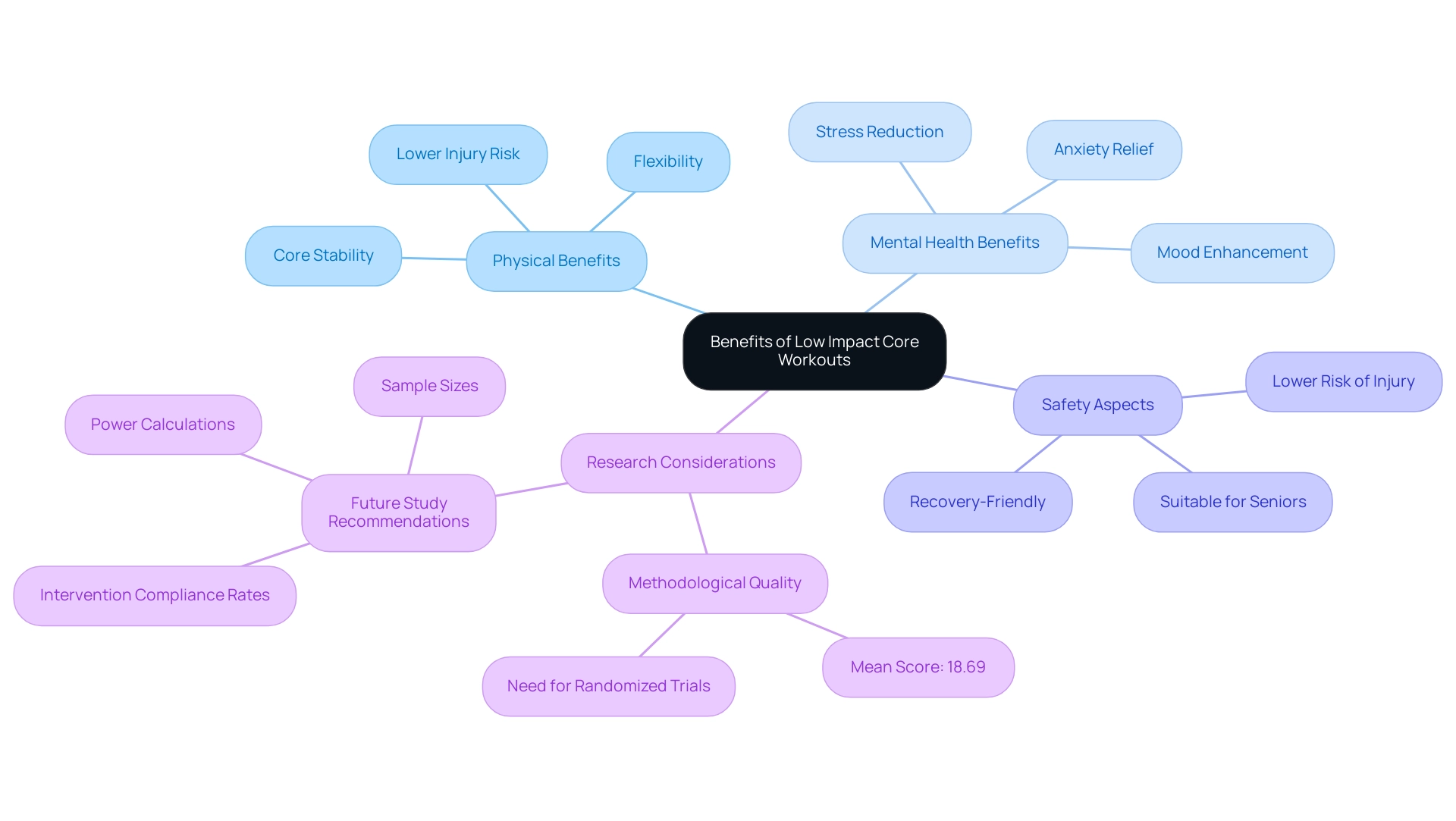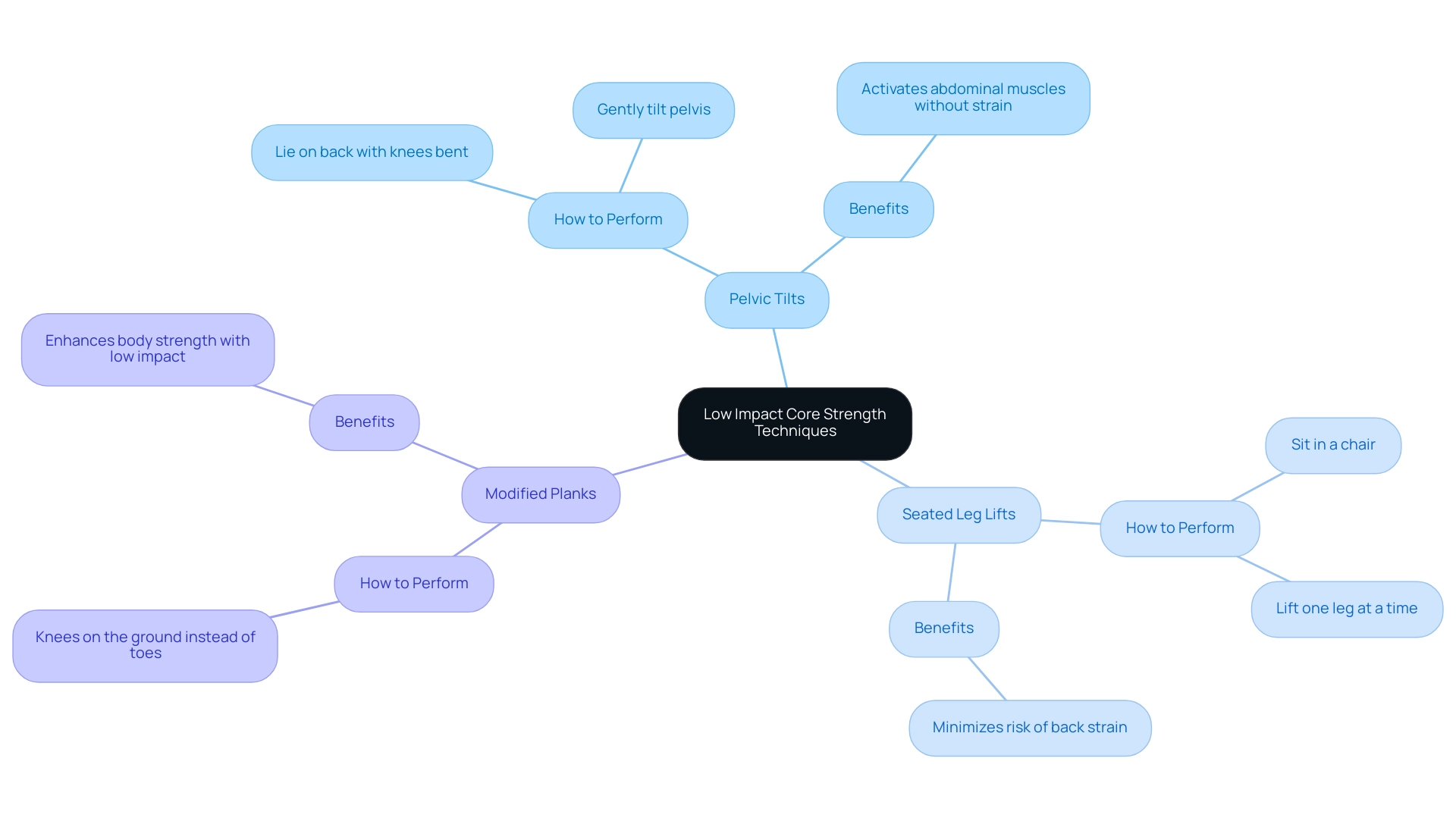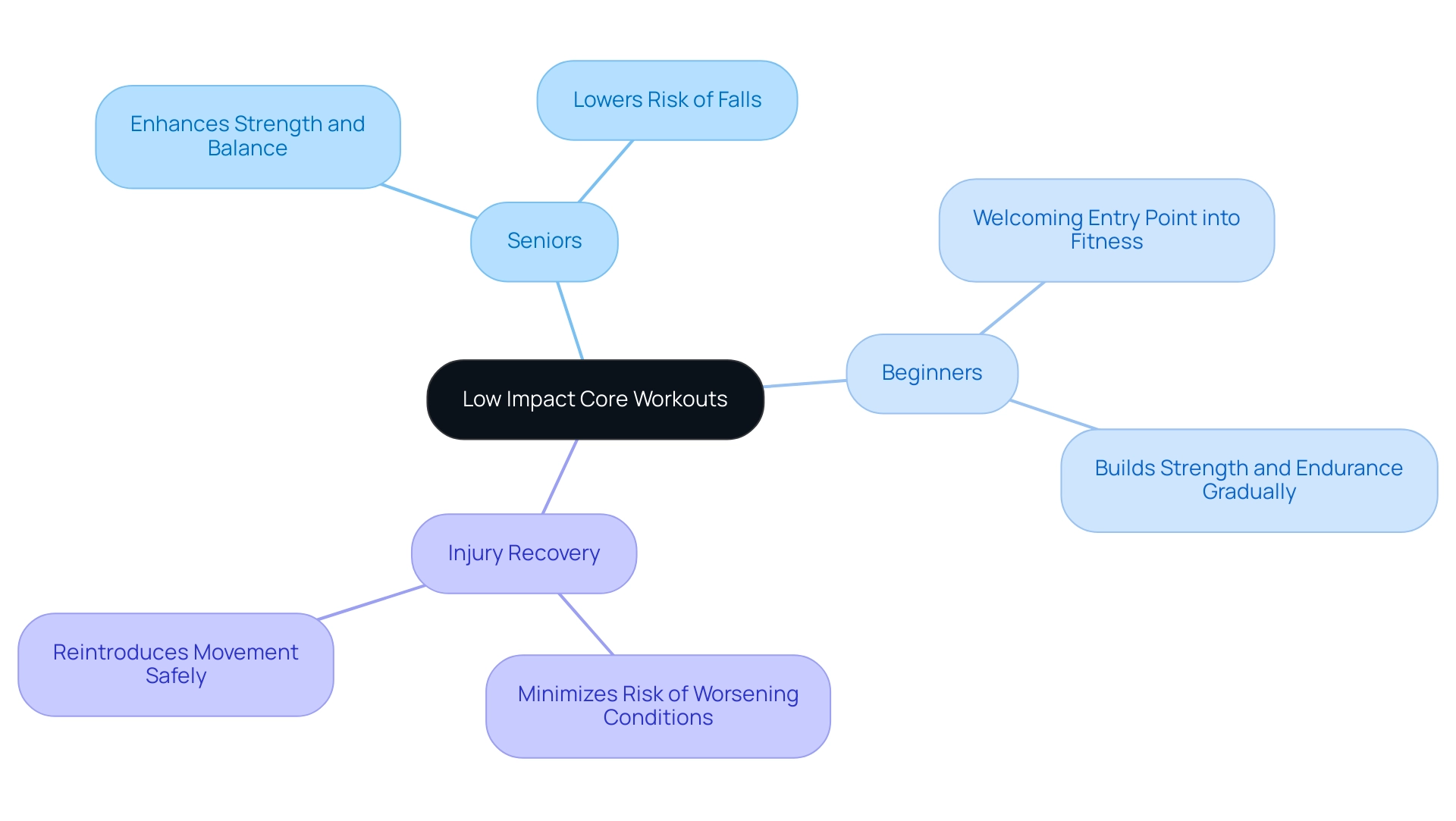Overview
Low impact core workouts are exercises designed to strengthen the core muscles while minimizing stress on the joints, making them suitable for beginners, seniors, and those recovering from injuries. The article highlights that these workouts not only improve core stability and posture but also enhance overall well-being by promoting physical activity in a safe manner, which can lead to better workplace performance and reduced absenteeism.
Introduction
In a world where workplace wellness is increasingly recognized as a cornerstone of employee satisfaction and productivity, low impact core workouts emerge as a vital solution for teams at every fitness level. These exercises not only bolster core strength but also significantly reduce the risk of injury, making them accessible to:
- beginners
- seniors
- those recovering from injuries
By embracing controlled movements that engage essential muscle groups, organizations can foster a culture of health and safety, ultimately leading to enhanced motivation and emotional well-being among employees. As the evidence mounts in favor of regular physical activity, HR Benefits Managers are uniquely positioned to champion these workouts, paving the way for a healthier, more engaged workforce ready to tackle challenges with vigor and resilience.
Defining Low Impact Core Workouts: What You Need to Know
Low impact core workouts are specifically designed to enhance midsection muscles while reducing strain on the joints, making them an ideal option for beginners, obese individuals, or those dealing with joint problems. Unlike conventional high-intensity routines that often involve jumping or rapid movements, these activities are designed as a low impact core workout that emphasizes controlled motions to engage the abdominal, back, and pelvic muscles. This method not only enhances fundamental strength but also significantly contributes to improved posture, movement efficiency, and overall wellness.
Research indicates that employees who participate in regular physical activity, including core workouts, report higher motivation and lower levels of fatigue and stress, ultimately leading to better workplace performance. A meta-analysis published in the journal 'Preventive Medicine' revealed that employees who engaged in physical activity for at least 30 minutes three times per week were more likely to report feeling motivated at work than those who did not participate in such activities. Furthermore, another study published in 'Workplace Health & Safety' found that participation in workplace fitness programs led to a reduction in absenteeism and presenteeism, highlighting the broader impact of fitness initiatives.
As Dr. Wendi Weimar, head of the Sport Biomechanics Laboratory, emphasizes,
So individuals will perform activities that they believe are targeting the ‘center’ but are not.
This highlights the significance of choosing the appropriate low impact core workout exercises that truly focus on strength in the center of the body. Furthermore, the interconnected nature of fundamental muscles contributes to various physical advantages, as illustrated in the case study titled 'Takeaway on Strength.'
By prioritizing a low impact core workout, HR Benefits Managers can cultivate a culture of health and safety in the workplace, encouraging their teams to engage in physical activity without the fear of injury associated with high-impact endeavors, thus enhancing motivation and emotional well-being.

The Benefits of Low Impact Core Workouts for All Fitness Levels
Low impact core workouts for the abdomen provide a variety of advantages for individuals at all fitness stages, particularly for novices and older adults. These activities significantly enhance core stability, which is essential for sustaining proper posture and avoiding back pain. They also enhance flexibility and balance, essential components for performing everyday activities with ease.
Importantly, a low impact core workout carries a lower risk of injury compared to high-impact alternatives, making it a safe choice for seniors and those recovering from injuries. As emphasized by fitness professionals, there are simple, low-impact bodyweight routines you can do at home to help reverse muscle loss and burn body fat. However, it is essential to note that the methodological quality of studies on low-intensity physical activity has been generally modest, with a mean score of 18.69 out of a highest possible score of 27.
This underscores the need for high-quality randomized controlled trials to better understand the relationship between low-intensity exercise and health outcomes, as discussed in the case study titled 'Challenges in Assessing Low-Intensity Exercise Efficacy.' Furthermore, future studies should focus on assessing sample sizes, power calculations, and intervention compliance rates to ensure rigorous research in this area. Beyond physical benefits, participating in these exercises can profoundly affect mental health.
Physical activity is known to release endorphins, which help reduce stress and anxiety, leading to an overall boost in mood. The present advantages of a low impact core workout extend well beyond the physical realm, serving as an excellent strategy to promote health and well-being in a safe and effective manner. By integrating these exercises into daily routines, HR Benefits Managers can significantly enhance the well-being of their teams.

Effective Techniques and Exercises for Low Impact Core Strength
A low impact core workout is essential for building strength safely and progressively, especially for beginners and those in office environments. Among the most effective techniques are:
- Pelvic tilts
- Seated leg lifts
- Modified planks
Pelvic tilts are simple yet effective; by lying on your back with your knees bent and gently tilting your pelvis, you activate your abdominal muscles without undue strain.
Seated leg lifts can be seamlessly integrated into a daily routine, performed while sitting in a chair, allowing individuals to lift one leg at a time to strengthen the abdominal muscles. This method is particularly beneficial as it minimizes the risk of back strain.
Modified planks, performed on the knees instead of the toes, offer an excellent method to enhance body strength while ensuring a low-impact experience.
Ioannis Tsartsapakis highlights the importance of such activities, stating,
These activities have been shown to effectively enhance the thickness of deep abdominal muscles through activation maneuvers.
Notably, the hollowing maneuver has been shown to result in a statistically significant increase in muscle relative thickness compared to the bracing maneuver, with a significance level of < 0.001. Furthermore, adding a ball circuit can further challenge the midsection and diversify training options.
A review titled 'Conclusions on Core Muscle EMG Activity' found that free-weight routines elicited the highest activity in abdominal muscles, underscoring the importance of EMG activity in effective training. By incorporating a low impact core workout into their fitness routines, individuals can progressively improve their central strength, ultimately contributing to overall wellness and heightened fitness levels.

Who Can Benefit from Low Impact Core Workouts? A Focus on Accessibility
Low impact core workouts serve as an empowering solution within corporate wellness programs, enhancing employee health and productivity. These workouts are particularly beneficial for:
- Seniors
- Beginners
- Those recovering from injuries
For seniors, participating in these activities enhances strength and balance, significantly lowering the risk of falls—an essential consideration that aligns with health professionals' calls to promote physical activity levels among US adults.
Moreover, statistics indicate that adults with diabetes have 35% lower chances of meeting physical activity recommendations compared to the general population, highlighting the significance of accessible exercise options in workplace wellness initiatives. Beginners find these gentle exercises to be a welcoming entry point into fitness, allowing them to build strength and endurance gradually. Individuals healing from injuries can confidently reintroduce movement and strengthen their central muscles, all while minimizing the risk of worsening their conditions.
By integrating a low impact core workout into wellness programs, HR Benefits Managers advocate for their teams' well-being, promoting a supportive atmosphere that aligns with worldwide health initiatives, such as the Global Action Plan on Physical Activity 2018-2030, which aims for a 15% relative decrease in physical inactivity by 2030. Additionally, these programs offer individualized guidance from dedicated health coaches and utilize a customized app to enhance engagement. This commitment emphasizes the role of well-being in enhancing workplace culture and overall employee satisfaction while also contributing to significant financial benefits, such as reduced absenteeism and lower healthcare costs.

Incorporating Low Impact Core Workouts into Your Fitness Routine
Incorporating a low impact core workout into your training regimen is a significant move toward improving overall health. Aim for at least two to three sessions each week, and as you grow more comfortable, gradually increase the duration and intensity of your workouts. Start every session with a warm-up to ready your muscles, followed by a range of fundamental activities customized to personal skill levels, ensuring everyone can participate.
Conclude with a cool-down to foster recovery and promote muscle health. Dr. Jessica Chan emphasizes,
It’s really about creating a good routine for yourself and picking something that you enjoy doing—and doing a lot of it.
Research has shown that active commuting, such as walking or cycling, is associated with reduced risks of all-cause mortality and cardiovascular diseases, highlighting the health benefits of incorporating physical activity into daily routines.
Additionally, the Short Physical Performance Battery (SPPB) indicates a standardized mean difference (SMD) of 0.52, supporting the effectiveness of a low impact core workout. To further improve your fitness plan, consider combining these essential exercises with other activities such as walking or swimming, which can enhance and diversify your routine. By regularly adopting a low impact core workout, especially for individuals with disabilities, you not only improve your health but also inspire those around you to embrace a more active lifestyle.

Conclusion
Embracing low impact core workouts presents an invaluable opportunity for organizations to enhance employee health and productivity. These workouts are designed to strengthen core muscles while ensuring safety, making them accessible to individuals at every fitness level, including beginners, seniors, and those recovering from injuries. By focusing on controlled movements, these exercises not only improve core stability and flexibility but also contribute to better posture and overall wellness.
The benefits extend beyond physical health, as engaging in regular low impact core workouts can significantly uplift mental well-being by reducing stress and anxiety. This holistic approach to fitness fosters a culture of health and safety in the workplace, encouraging employees to prioritize their well-being without the fear of injury associated with high-impact activities.
For HR Benefits Managers, the integration of low impact core workouts into wellness programs is a strategic move that can lead to increased motivation, reduced absenteeism, and enhanced employee satisfaction. By championing these workouts, organizations can cultivate a more resilient and engaged workforce, ready to tackle challenges with renewed vigor. Now is the time to take action and make low impact core workouts a cornerstone of corporate wellness initiatives, paving the way for a healthier, happier workplace.
Frequently Asked Questions
What are low impact core workouts?
Low impact core workouts are designed to strengthen midsection muscles while minimizing strain on the joints. They focus on controlled movements to engage the abdominal, back, and pelvic muscles, making them suitable for beginners, obese individuals, or those with joint issues.
Who can benefit from low impact core workouts?
These workouts are particularly beneficial for novices, older adults, and individuals recovering from injuries, as they enhance core stability, flexibility, and balance while carrying a lower risk of injury compared to high-impact exercises.
How do low impact core workouts affect workplace performance?
Regular participation in physical activity, including low impact core workouts, has been linked to higher motivation and lower levels of fatigue and stress among employees, which can lead to improved workplace performance.
What does research say about the effectiveness of low impact core workouts?
Research indicates that employees who engage in physical activity for at least 30 minutes three times a week report feeling more motivated at work. Additionally, workplace fitness programs have been shown to reduce absenteeism and presenteeism.
What are the mental health benefits of low impact core workouts?
Engaging in physical activity, such as low impact core workouts, releases endorphins that help reduce stress and anxiety, contributing to an overall boost in mood and emotional well-being.
Why is it important to choose the right low impact core workout exercises?
Selecting appropriate exercises is crucial as many activities may not effectively target the core. Proper low impact core workouts focus on strengthening the center of the body, which can lead to various physical advantages.
What are some considerations for future research on low intensity exercise?
Future studies should focus on improving methodological quality, assessing sample sizes, power calculations, and intervention compliance rates to better understand the relationship between low-intensity exercise and health outcomes.

